| |

Singapore's Chinatown district with colorful Chinese lanterns.
Old and new buildings make up Singapore skyline.
When I recently told a friend I had gone to Singapore, she said, “hmm ... hard for me to get excited about Singapore. Hope it was a gateway.”
Well, no, it was not. It was my destination.
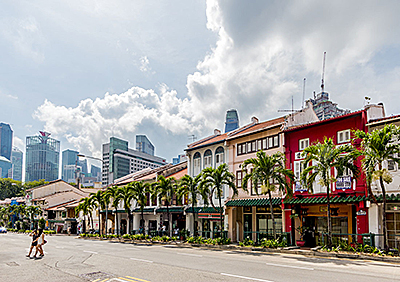
Typical shophouses in Singapore's Chinatown district.
Shophouses are mostly two or three stories high, with a shop on the
ground floor
for mercantile activity and a residence above the shop.
This hybrid building is popular in the historical centers
of most towns and cities in the Southeast Asia region.
And I loved it.
Understand, this is no third world country. Kind of reminds me of Korea, the way everything has been updated and, yes, sanitized.
There is, of course, the well known "Way of Singapore Life" ... no spitting, no chewing gum, no, well, a lot of stuff. For instance, rainwater belongs to the state. Locals can’t collect their own.
And the government heavily recommends (and that means virtually orders) locals to buy a new car every 10 years. That, a local friend explained in a way that made me understand he thoroughly agreed, is so beater cars don’t break down on the highways and thus, hold up Singapore’s main purposes in life—business and efficiency.
| |
|
|
|
|
| |
Sikh doorman at entrance to Raffles Hotel, which was built in 1887 and has become Singapore's best known icon. In recent years, it has been extensively remodeled and modernized. It was named after Stamford Raffles, the founder of modern Singapore. |
|
Woman plays harp during high tea in Raffles Hotel. The hotel is managed by Fairmont Raffles Hotels International and houses a tropical garden courtyard, museum, and Victorian-style theater.
|
|
One upside is no, or at least very little, crime.
I went out for breakfast one morning and somehow left my hotel room door ajar. Came back hours later (not my original intention) and not a thing had been touched... not my expensive laptop or my cell phone or any of the other goodies you leave lying around when you think you’ve just stepped out for a few minutes.
Okay, what DID I like about Singapore.
| |
|
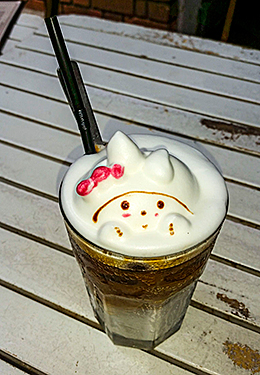 |
|
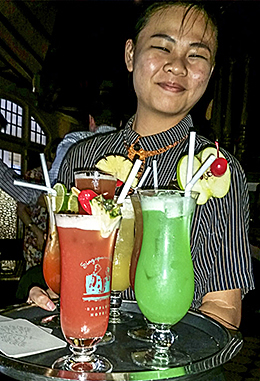 |
|
| |
|
3D iced "art latte" served at Chock Full of Beans, a coffee shop/deli in the Changi Village district of Singapore. The foam is formed into a three-dimensional sculpture. |
|
The REAL Singapore Sling, done with with a multitude of liquors and juices, at Raffles Hotel, the iconic Victorian era hotel where people have had Slings for 100 years |
|
First and foremost, at least for me, Gardens by the Bay, which I will describe later.
And the various ethnic neighborhoods.
And the food.
And the public transportation, which is saying a lot for someone (me) who loathes public transit.
And the nightlife.
And more food.
First, a bit of information. Singapore is a group of islands that sit just off the very southern tip of the Malay Peninsula, about 80 miles north of the Equator. The main island is 14 miles north to south, 26 miles east to west, about 3.5 times larger than Washington DC.
It’s a city state, meaning the entire tiny country is a single city which is then divided into many districts.
It’s also less than 200 years old. Modern Singapore was founded in 1819 by Sir Thomas Stamford Raffles as a trading post of the East India Company.
But for much of that time, Singapore had a somewhat sketchy reputation. It was Lee Kuan Yew who forged the Singapore of today with its emphasis on rapid economic growth, support for business entrepreneurship and, yes, also limitations on democracy. Today, it is one of the world's major commercial hubs, the fourth-largest financial center and one of the five busiest ports.
| |
 |
|
View of famous Marina Bay Sands hotel at night - Marina Bay Sands, opened in 2010, is a 2,561 room hotel along Marina Bay in Singapore. Developed by Las Vegas Sands, it is billed as the world's most expensive standalone casino property at S$8 billion. The hotel has a convention center, upscale shops, theaters, seven restaurants, an ice skating rink, a casino and is topped by a 340 metre long (310 yard long) SkyPark with a capacity of 3,900 people and an infinity swimming pool, set on top of the world's largest public cantilevered platform. Here, the hotel is seen from the rooftop bar of IndoChine restaurant in Gardens by the Bay. |
|
Surprisingly, I found Singapore to be a great walking city. I’m not big on huge, gleaming megahotels so stayed in the New Majestic, a boutique hotel with 30 rooms and a pool just a couple of blocks from the light rail system. It was also just blocks from the center of Chinatown, with its shopping stalls, some impressive temples and lots of small eateries.
And the other districts - Little India, the Malay District (known as Kampong Glam), Tiong Bahru with its food courts and others - are also great for walking.
Ah, let’s get to the good stuff - rooftop views, must-see spots and FOOD! But first, the views:
* The place everyone heads to is the Marina Bay Sands Skypark Observation Deck. You can’t miss the hotel, one of Singapore’s most distinctive. It stands like a three legged tower with a massive boat sitting completely across its top. That boat is the rooftop deck, with swimming pool, bar, restaurants, palm trees. It’s $17 to go up and the views are spectacular. But...
* For killer city views at a bargain $3.70, head to the 50th-floor rooftop of Pinnacle, the world's largest public housing complex. Cabrini Green it decidedly is not. Landscaped and dotted with artwork and beach chairs, its skybridges connect seven towers and provide a gobsmacking, 360-degree sweep of city, port and sea.
* 1-Altitude, an intense millennial-focused bar, 63 stories up the OUB (United Overseas Bank) Building comes with strobe lights, booming music, exotic drinks, magazine cover model locals looking like they stepped out of Maserati ads, and all this from the highest viewpoint of the city.
* And my serious fave, the rooftop bar and walking platform of IndoChine, the restaurant atop the tallest “supertree” of Gardens by the Bay. It comes with views of the Sands, of the Singapore Flyer ferris wheel and so much more. Yes, it’s lower than 1-Altitude, but the rooftop has plenty of room for you to set up a tripod and photograph the skyline without glass or strange railings or a crush of bodies in your way.
| |
 |
|
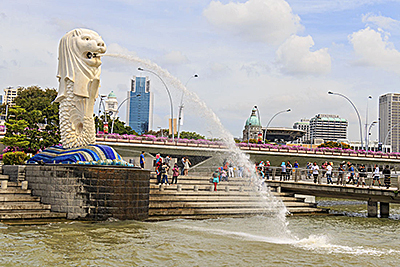 |
|
| |
Rug shop in Singapore's Little India district
|
|
Famous Merlion statue along the Singapore River. It has become a marketing icon and is used as a mascot and national personification of Singapore. Merlions do not feature in any local folklore or myths of Singapore, and was only used in Singapore initially as the logo for the tourism board. |
|
Meanwhile, Singapore truly comes to life at night.
No amount of outdoor air conditioning and giant sun shades could convince folks to do Clarke Quay by day thanks to sweaty equatorial heat. But at night, the transformed warehouse district becomes a magical fantasyland of moving lights, bustling shops and pubs attracting two million people a year.
Gardens by the Bay, spectacular enough by day, turns into magic at night. And just about any street shimmers with brilliantly colored lights.
| |
|
|
Lit SuperTrees seen at night at Gardens by the Bay, a $1 billion park on reclaimed land in central Singapore. Two huge domes enclose gardens, one with drier Mediterranean plants including varieties of cactus, the other a tropical garden with a 138-foot tall “Cloud Mountain” that is circled by a walkway. The main feature of Gardens by the Bay are the 18 SuperTrees, huge tree-like towers covered in exotic ferns, vines, orchids and bromeliads that are lit at night and become a sound and light show of shifting colors. There is also a 72-foot high elevated walkway, the OCBC Skyway, between two of the larger Supertrees. |
|
Now, on to the food.
It’s truly hard to eat badly in Singapore. But the days of locals squatting along sidewalks serving delicacies from steaming woks is long, long gone. Street food is now all inside, in well regulated food courts. One of the best known is in Tiong Bahru Food Centre but truthfully, you can find a food court just about anywhere.
A short stroll from my hotel, I stumbled upon China Town Food Street with, among many, many other things, noodle soups, prawn fritters, half a dozen varieties of duck, crispy fried carrot cake, oysters, assorted BBQ seafoods - Indian, Vietnamese, Korean, vegetarian and a scattering of places that advertise they are organic.
And, then there are the sit-down restaurants. Literally across from my hotel was Candlenut, a Peranakan (a blend of ethnic Chinese/Malay and more) restaurant where dishes were served family style to the table. We had Ngoh Hiang - deep fried beancurd rolls stuffed with minced pork, various coconut curries and (okay, I didn’t say this was my favorite) stinky durian ice cream.
| |
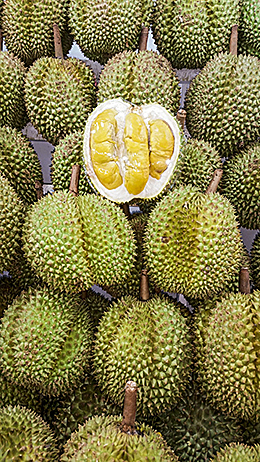 |
|
|
|
| |
Stinky durian fruit in market - Famously smelly durian fruit, for sale at a night market in Singapore. The sickly sweet smell from this fruit is so intense, it is banned from some public transportation and hotels in tropical Asia. |
|
The Intan, a private museum owned and run by Alvin Yapp who realized his Peranakan/Chinese heritage was being lost. So he started accumulating antiques. Here are examples of beaded slippers, each of which is worth at least $1,000 and took an average eight months to make. |
|
At Clarke Quay, we dove into the iconic “chilli” crab at Jumbo. Honestly, the crab with its hard shells covered in chili sauce, was more trouble than it’s worth. But the rest of the fish dishes - prawns, seafood rice, braised abalone in oyster sauce, some kind of whole fish - were fantastic.
For casual local places, there was Char, which focuses on Chinese style meats and included a surprisingly tasty beef lung dish and more kinds of pork than I could count.
For fancy, there was IndoChine atop the tallest “SuperTree” at Gardens by the Bay. My vote for the absolute best, perhaps of the whole trip, was a Vietnamese dish called Thit Heo Kho, braised pork belly with quail eggs in coconut cream set in a coconut husk and served with fresh coconut slices. The pork was so tender, it almost had no substance and was intensely flavored.
But one of the sweet little surprises of the trip was a coffee bar in the Changi Village district where I discovered an amazing mango bacon sandwich and 3D art lattes where somehow they carve standing foam kitties, piggies and whatnot atop iced lattes. The regular, western sandwiches (roast beef for one) were of impeccable quality with fresh lettuce, medium rare roast beef slices and thick homemade bread.
Sorry, you do not go to Singapore to lose weight.
We did come up for air occasionally to do something other than eat.The details are in my sidebar.
Would I go back to Singapore? Yes, absolutely. Only this time I would spend an entire week instead of just a few days.
| |
|
|
|
|
| |
Butterfly Garden in Changi, Singapore's international airport. This garden, in Terminal 3, is one of four gardens in the airport. Changi has been voted best airport in the world for dozens of categories (approximately 480 awards over two decades at last count) including shops, entertainment and best airport to sleep in. There are approximately 350 retail and services outlets plus 120 restaurants, cafes and bars. |
|
Buddha Tooth Relic Temple and Museum in Singapore's Chinatown district. The temple is based on the Tang dynasty architectural style and built to house the tooth relic of the historical Buddha. It opened in 2007 and has become one of the area's most popular tourist attractions.
|
|
TO DO
Things you really shouldn’t miss in Singapore:
* The National Museum, with its really great history of the island including a comprehensive look at the Japanese occupation during WWII.
* The Intan, a curious private museum owned and run by Alvin Yapp who woke up one day and realized his Peranakan/Chinese heritage was being lost. So he started accumulating antiques including an intricately carved Chinese ancestral altar, rare porcelain ware, hundreds of stunningly valuable beaded slippers and so much more. The tour includes a great talk by Alvin. You can also arrange for a dinner in the museum, prepared by his mother * Bumboat ride on Singapore River. It’s actually a river taxi with many stops along the way. You can hop on and off (they come every 10/15 minutes) or do the whole trip, which takes about 40 minutes and costs about $18.
* Yes, high tea or a Singapore Sling at Raffles Hotel. Of course, neither is cheap. Tea is $43 (plus 16% tax) but it’s a slice of history, as is the $22 Singapore Sling, which here is done the “real” way with a multitude of liquors and juices. Reservations are necessary. Make them a few days in advance during slow seasons but a month or more in advance during holidays.
* Changi WWII War Trail + Museum Tour. Bus to a war museum, beachfront site of battles, chapel and a huge defense canon.
* Public transportation. The light rail system is clean, efficient and cheap. It’s a great way to whisk through the countryside.
* Orchard Road, the mile-long high end shopping mecca flanked by upscale pedestrian shopping centers. Name the international gourmet food shop or highest end store - Prada, Armani, Louis Viutton, Dior, Cartier - and it’s here.
* Changi airport - honest. It’s won so many international “best this” and “best that” awards that they can hardly keep count (480 at last tally). Even before you clear security, there’s a four-story slide and countless shops and restaurants. It’s so popular with locals that students come here to study. Then once through security, there are gardens, restaurants, children’s play areas, a hotel, a swimming pool and a free movie theater showing full length recent movies. There is also a quiet zone for people with long layovers including massage lounge chairs where you can even ask for a bed cover. And yes, Changi has been voted best airport to sleep in for 18 years in a row.
* Finally, the "best of the best," Gardens by the Bay - a grove of “SuperTrees,” two garden domes and restaurants. Entrance to the general grounds and the nightly sound and light show is free, though the garden domes are not. There’s a drier Mediterranean dome with more cacti than you knew existed and the tropical dome with an encircling, elevated walkway, waterfalls and killer views. The SuperTrees, ranging from 80 to 160 feet tall, are covered in tropical plants and lit at night so that they transform into a scene from the movie Avatar. Plus, threading through the grounds is an elevated, outdoor walkway.
| |
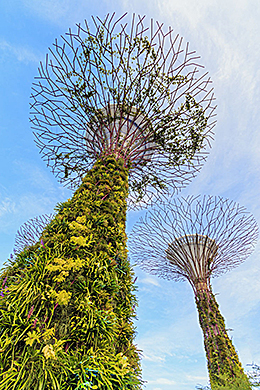 |
|
SuperTrees seen in daylight at Gardens by the Bay, a $1 billion park on reclaimed land in central Singapore. Two huge domes enclose gardens, one with drier Mediterranean plants including varieties of cactus, the other a tropical garden with a 138-foot tall “Cloud Mountain” that is circled by a walkway. The main feature of Gardens by the Bay are the 18 SuperTrees, huge tree-like towers covered in exotic ferns, vines, orchids and bromeliads that are lit at night and become a sound and light show of shifting colors. There is also a 72-foot high elevated walkway, the OCBC Skyway, between two of the larger Supertrees. |
|
INFO
Singapore is a city state on an island just off the southern tip of the Malay Peninsula. It’s about 80 miles north of the equator which means heat and humidity. Temperatures hover at 90 degrees during the day with little seasonal variation, although it's slightly cooler in December and January, and hottest in April and May. It rains year round but the rainiest months are December and January.
Contacts:
Singapore - http://www.yoursingapore.com/
Gardens by the Bay - http://www.gardensbythebay.com.sg/en/home.html
National Museum of Singapore - http://www.nationalmuseum.sg/NMSPortal/
The Intan - http://the-intan.com/
Clarke Quay - http://www.clarkequay.com.sg/en/
Raffles Hotel - http://www.raffles.com/singapore/
Changi WWII War Trail tour - http://www.journeys.com.sg/singaporewalks/tours_changiww.asp
For a photo diary of my trip to Singapore: https://plus.google.com/u/0/116146064817580609744/stories/02d08940-8250-3a44-b174-dcc4094a1d1514caf57bfb1?cfem=1
| |

|
|
|
|
| |
Cloud Forest at Gardens by the Bay. Photo by Gardens by the Bay.
|
|
Author Cardozo and airport manager pose for 'selfie' at Changi Airport's Social Tree. Photo courtesy Changi Airport. |
|
Singapore Technology
The hotel calls it a “handy phone.” It looks like a Samsung knockoff though the name on the back says Alcatel Onetouch. It appears to be Android though the home screen looks like a Windows PC model.
But best of all, it’s free. It’s the city in your pocket. And you can phone home practically anywhere on earth, unlimited and without charge.
I didn’t entirely understand any of this when the guy at the front desk handed this thing to me when I checked in at the New Majestic Hotel in Singapore.
And then I started to learn.
* It will create a hotspot for your own phone, enabling you to check email, send messages, post to Instagram, whatever, on your own phone, from anywhere in Singapore.
* It is a travel guide - food, attractions, shopping suggestions - near wherever you are plus VERY handy Google maps.
* Taxi card - punch it and up comes a page in assorted languages that shows the name and address of your hotel, where you are on the map and a tab to call the hotel if needed.
* A quick tab to find the phone’s own number.
* A camera for still pictures or videos (you then send the image to your own email address).
* Of course, a phone.
* And most amazing, the ability to call, for free, any one of 15 major countries.
It is the latest amazing tech feature for travelers in a menu of dazzling goodies.
I encountered another interesting and VERY helpful bit of tech before reaching Singapore on my Delta flight from Seattle. This discovery is a Delta app called My Delta for smartphones that lets you track your checked bag. How comforting to know your luggage is actually somewhere below you during the flight.
Once you have downloaded the app (iPhones and android phones), you can track your bag if you have a wi-fi connection.
You access it through Delta.com, the airline’s own and free wi-fi. It’s good only for accessing Delta info and their bag tracker. You won’t be able to use it to, say, check email. For that, you need to pony up as much as $30 per segment to access something called Gogo Inflight Internet.
Or, to save LOTS of $$$, buy Gogo before you leave via http://www.gogoair.com/gogo/splash.do. It’s $59.95 for a month of unlimited service on any of the nine airlines and 1,000 flights that have the service or $16 for a single day of unlimited service.
When it works, there are a couple of other things you need to bring with you—your Delta frequent flier number and, of course, your bag confirmation number. It's located on that sticky tab they plastered onto the back of your boarding pass.
Then it’s just a matter of navigating the app. It will also tell you your flight info - time, arrival gate and even the gate number of your next flight.
As for the working part, Delta is busily upgrading its planes. All domestic aircraft except the very smallest, now have wi-fi and nearly half of their international planes have it with plans to finish the job by middle of next year.
|
|